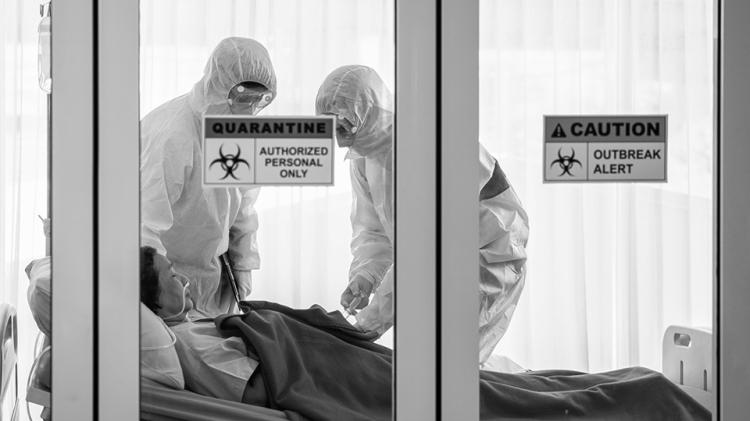The Mystery of SARS-CoV-2 Unravelling
Facing the novel biological threat SARS-CoV2 has inspired versatile scientific studies around the subject. Researchers´ interests worldwide have been aimed to investigate e.g. the mode of transmission, the easiness of spreading and sustainability of the coronavirus.

During the nascent pandemic, health authorities like the U.S. Centers for Disease Control and Prevention (CDC) and World Health Organization (WHO) warned us from viral spreading in close contacts via larger respiratory droplets produced by coughing and sneezing and via surfaces contaminated with virus. This led to instructions for intensive hand washing, covering sneezes and coughs, avoiding touching faces, staying home when feeling sick and active cleaning and disinfecting of surfaces and later, keeping the distance of 1 – 2 meters in close contacts, too. However, naturally produced droplets by humans in the course of breathing, talking, sneezing, coughing and even singing are likely to vary in both size and content. Typically, droplets > 5 μm tend to fall to the ground under gravity, and are transmitted over a limited distance (e.g. ≤ 1 m) and remain trapped in the human upper respiratory tract. On the contrary, droplets ≤ 5 μm can remain suspended in air for significant periods of time, allowing them to be transmitted over distances (> 1 m) and having the potential to be inhaled into the human lower respiratory tract. The definition for a droplet may vary, but the fact is that the naturally produced aerosols will contain a range of droplet sizes, whose motion will depend significantly on various environmental factors. These include gravity, the direction and strength of local airflow, temperature and relative humidity, the latter affecting both the size and mass of the droplet due to evaporation. (WHO 2009)
The possibility for SARS-CoV-2 transmission as small aerosols has raised a lot of debate lately, and the use of facial masks as well. This all is related to the recent research that has pointed out an important and underscored topic, even though the importance of infectious bioaerosols in disease transmission in a general level has been long-acknowledged, and there is scientific evidence that supports this mode of transmission.
The subject itself is really not new. Already during the previous SARS-CoV-1 epidemic, researchers indicated that airborne SARS transmission may have occurred in aircrafts during flights (Olsen ym. 2003). In addition, viral aerosol generation by SARS patients was shown as positive PCR samples obtained from a room occupied by them (Booth ym. 2005). With the PCR techniques, it is possible to show the existence of the viral genome (RNA) in the samples collected, but of course it leaves the question of infectivity/viability of the virus in the samples still open. A different approach, modelling of airflow dynamics, suggested airborne transmission could account for transmission patterns of SARS in a multiple high-rise apartment complex in Hong Kong (Li ym. 2004).
Furthermore, it seems that a significant fraction of human expired aerosols is formed by particles of < 10 μm in diameter across all types of activity like breathing, talking and coughing (Johnson ym. 2011), and upper respiratory illness increases production of aerosol particles in the same size category (Lee ym. 2019). These kinds of particles stay airborne for longer periods of time, remain floating and are transported with the air flows created e.g. by HVAC systems of buildings and people movement. Taking ventilation into account, a Finnish research consortium has just recently modelled the airborne movement of aerosol particles < 20 μm in a scenario where a person coughs in an aisle between shelves of a grocery store. The preliminary results show that the aerosol cloud spreads outside of the immediate vicinity of the coughing person and dilutes in the process, but this can take up to several minutes. (Aalto University 2020).

In practice, one may think what might happen, when a super spreader of the SARS-CoV-2 coughs, sneezes, talks and exhales among of us e.g. in an indoor space and leaves behind a plume of variety of aerosol particles in different sizes carrying the virus. Van Doremalen et al. have also shown that the concentration of SARS-CoV-2 is diluted in the air, but the virus is capable of retaining its viability as an aerosol for three hours and on different surface materials even for days (van Doremalen et al. 2020). Santarpia et al. have found that notable contamination by SARS-CoV-2 takes place in spaces occupied by CoV-19 patients and even outside of these spaces, independent of the symptoms or the stage of the infection. This research shows that SARS-CoV-2 is shed during respiration, toileting, and fomite contact, indicating that infection may occur in both direct and indirect contact. (Santarpia et al. 2020) Morawska & Cao have reviewed and discussed the past and recent findings related to the airborne transmission route and emphasized the urgent need for recognition and acknowledgment of this fact by the national and international health authorities in order to implement adequate actions against it (Morawska & Cao 2020).
Surely, there are many players in the Game of Corona – partly known and partly still unknown, but to be taken seriously anyway, not denying them. Understanding the modes of transmission of emerging infectious diseases forms a key factor in protecting people, including the vital healthcare workers and implementing effective public health measures. The scientific community is currently working hard to understand the different properties of the virus, its behavior and transmission, as well as to develop testing for the antigen and antibodies and the vaccine against the virus. Environics wants to take part in this important work and provide its bioaerosol detector, ENVI BioScout, for studying the existence of airborne SARS-CoV-2. The study is ongoing with the South Savo Social and Health Care Authority, and it aims to produce information on the presence and airborne transmission of the virus in health care settings and spaces related. The results are gathered along with the evolving national CoV-19 epidemic.
References:
Aalto University. 2020. Researchers modelling the spread of the coronavirus emphasise the importance of avoiding busy indoor spaces.
Booth, T.F., Kournikakis, B., Bastien, N., Ho, J., Kobasa, D., Stadnyk, L. et al.. 2005. Detection of airborne severe acute respiratory syndrome (SARS) coronavirus and environmental contamination in SARS outbreak units. The Journal of Infectious Diseases 191, 1472–1477.
Johnson, G., Morawska, L., & Ristovski, Z., Hargreaves, M., Mengersen, K., Chao, C., Wan, M-P., Li, Y., Xie, X., Katoshevski, D., Corbett, S. (2011). Modality of human expired aerosol size distributions. Journal of Aerosol Science 42, 839-851.
Lee J., Yoo, D., Ryu, S. Seunghon Ham, S., Lee, K., Yeo, M., Min, K. & Yoon, C. 2019. Quantity, Size Distribution, and Characteristics of Cough-generated Aerosol Produced by Patients with an Upper Respiratory Tract Infection. Aerosol and Air Quality Research 19, 840–853.
Li, Y., Duan, S., Yu, I.T.S. & Wong, T.W. 2004. Multi-zone modeling of probable SARS virus transmission by airflow between flats in Block E, Amoy Gardens. Indoor Air 15, 96–111.
Morawska, L. & Cao, J. 2020. Airborne transmission of SARS-CoV-2: The world should face the reality. Environment International 139, 1 – 3.
Olsen, S.J., Chang, H.-L., Cheung, T.Y.-Y., Tang, A.F.-Y., Fisk, T.L., Ooi, S.P.-L., et al.. 2003. Transmission of the severe acute respiratory syndrome on aircraft. The New England Journal of Medicine 349, 2416–2422.
Santarpia, J.L., Rivera, D.N., Herrera, V. , Morwitzer, M.J., Creager, H. , Santarpia, G.W., Crown, K.K., Brett-Major, D.M.Schnaubelt, E., Broadhurst, M.J., Lawler, J.V., Reid S.P. & Lowe, J.J. 2020. Transmission Potential of SARS-CoV-2 in Viral Shedding Observed at the University of Nebraska Medical Center. medRxiv. Preprint Server For Health Sciences.
Van Doremalen, N., Bushmaker, T. , Morris, D.H., Holbrook, M.G., Gamble, A. , Williamson, B.N., Tamin, A., Harcourt, J.L., Thornburg, N.I., Gerber, S.I., Lloyd-Smith, J.O., De Wit, E., Munster, V.J. 2020. Aerosol and surface stability of HCoV-19 (SARS-CoV-1 2) compared to SARS-CoV-1. medRxiv. Preprint Server For Health Sciences.
WHO. 2009. Natural Ventilation for Infection Control in Health-Care Settings.
Learn more on
Thank you for sharing such a blog!
King regards,
Thompson Raahauge